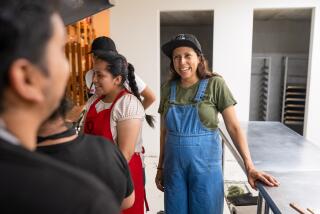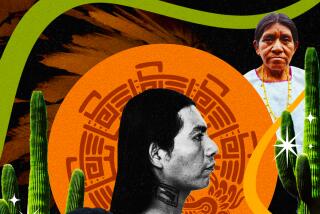Costa Rica Project : It’s Feed an Iguana, Save a Tree
EL LIMONAL, Costa Rica — The West German zoologist greeted 50 Costa Rican peasants in the shade of a sprawling fig tree. “Good afternoon,” Dagmar Werner told her guests with a half-smile. “I am Mama Iguana.”
Languishing in three long rows of cages behind Werner was her adopted brood--2,350 green iguanas. For people who have hunted the tree-dwelling lizard into near extinction, it was an impressive sight.
“Man has eaten iguana for thousands of years, but they are disappearing,” she began the lecture. “Now we can help you bring them back. We can help you grow them in your back yard.”
Ranch Animals
The city of captive iguanas and the campaign to get tropical farmers to raise them as ranch animals are the work of Werner’s Green Iguana Foundation, one of the most promising conservation ventures in Latin America.
Its ultimate aim is to save the region’s rain forests, which are being slashed and burned in order to clear land for crops and cattle. In many areas the destruction is so wanton that soil erosion exhausts the fields within a few years, prompting the farmer to attack the forest anew.
Werner’s formula for salvation: Instead of cutting down trees, peasants are being encouraged to plant new ones to help iguanas thrive. If reared in captivity and released as yearlings into the wild, she says, the herbivorous reptiles can, within two years, yield at least as much high-protein meat per acre as cattle. With that economic incentive, farmers could save the forest not only for iguanas but for other endangered species.
‘The Iguana as Buffer’
“I want to use the iguana as a buffer to keep people from destroying the forests,” Werner said. “I want to show that with reasonable management you can make equal production and money without ruining the environment.”
Before Werner ever met an iguana, the notion of raising the timid creatures had been entertained--and dismissed--by other scientists.
The iguana’s known mortality rate in the wild, where floods and predators destroy half of its eggs and just 4% of all hatchlings survive one year, is dauntingly high. And several human attempts to incubate its eggs had failed.
But the Swiss-educated Werner, who earned her doctorate while studying iguanas on Ecuador’s Galapagos Islands, has overcome the obstacles with a speed that astonished her colleagues.
“In five years, she has domesticated an animal we thought would take a century to learn to manage,” said Ira Rubinoff, director of the Smithsonian Tropical Research Institute in Panama, which helped launch Werner’s project in 1983. “She hit all the right buttons. It was good luck and good intuition.”
Imitating what she observed in nature, Werner first fashioned a laying nest by burrowing one end of a drainage pipe into an underground chamber of concrete blocks. “My oldest and most elegant trick,” she called it. The morning after she set it in the wild, the nest was filled with eggs.
Next, she buried hundreds of eggs in incubators made of Styrofoam ice chests filled with soil. About 95% hatched on the first try--a fast start for the experimental colony.
Then came the risky part. Iguanas take three years to reach their full length of 6 feet or more, and it is not economical for a farmer to keep them caged that long. Werner decided to free most of them at the age of 7 months and set up feeding stations in the forests. While adapting quickly to the wild, each iguana stuck to a chosen area and nearly half survived to adulthood.
“That gave us the security to tell the farmer that if he raises iguanas in his back yard, they won’t run away,” she said. “It’s as easy and predictable as raising free-range chickens, and much cheaper. The iguana just sits in the trees and nibbles leaves.” Hence its local nickname-- gallina de palo , or chicken of the trees.
According to Werner’s calculations, a farmer can raise 100 6 1/2-pound iguanas a year in 2 1/2 acres of forest and produce 480 pounds of meat, a better yield than is achieved on many Latin American cattle ranches. At 50 cents a pound, farmers could earn about $2.50 per iguana while improving the family diet with tasty white meat that belies the scaly reptile’s unappealing appearance.
To put her theories to work, Werner released thousands of iguanas from her research colony into two rural Panamanian villages in 1986. Farmers were given materials to build cages, nests and incubators, plus the counsel of a biologist and a forester. Everything was free except the farmers’ labor.
Planting Trees
Although not yet time to hunt those lizards, “the villagers are absolutely enthused about seeing them multiply and are planting trees like mad,” Werner reported. “Nobody burns the forest any more.”
A third farming colony was set up in Panama last year and a fourth is to be opened on a Costa Rican Indian reservation in February. To discourage poaching, Werner stages a pomp-filled inauguration in each new colony, with priests, village elders and government authorities pledging support for the project.
But just as the idea was catching on, Werner’s research colony--the key to further advances in iguana management--was suddenly threatened. Its $500,000 start-up grant from the W. Alton Jones Foundation, a Virginia-based conservation organization, ran out last year, and Panama’s political turmoil made new funds hard to come by. Werner moved the colony--her 2,350 “Panamanian exiles”--to Costa Rica.
The trip was a near disaster. Hurricane Joan cut the Pan American Highway with mudslides. For several days 1,200 of the caged specimens--three generations whose meticulously recorded development has revealed much of what is known about iguanas--were stranded in a moving van and nearly suffocated.
“We almost lost five years of research,” Mama Iguana said.
She told this story during an hourlong drive from the Costa Rican capital to the research colony’s new home here on a ranch in the Pacific coastal lowlands. A wicker iguana swung from the rear-view mirror of her Toyota pickup.
A jovial woman with straw-colored bangs, Werner laughs and talks with husky self-confidence about her patient, systematic scheme for reviving the rain forest. But she admits to being somewhat bewildered about the politics of financing such work.
After moving to Costa Rica, Werner got money from the World Wildlife Fund, the Dutch Embassy, the U.S. Fish and Wildlife Service and the International Union for the Conservation of Nature. But it is not enough to expand her research or even maintain it beyond this year.
To help support itself, the growing research colony will soon start exporting some of its superfluous iguanas to the United States and other foreign markets, to become pets or handbags.
“We don’t want to be all the time dependent on the fund givers,” Werner said. “I’m sick and tired of having to beg. They should throw millions after me.”
Driving onto the ranch, Werner found her employees working feverishly to expand the incubator zone for an expected 13,000 eggs, which were starting to turn up in the nests a week early.
Then she put 12 graduate students from her University of Costa Rica wildlife course to work weighing and measuring the yearlings that, thanks to experimental breeding and something like chicken feed, are already three times bigger and reproduce a year earlier than their cousins in the wild.
In cages the size of small houses, made of tin walls and fishnet roofing, the older iguanas were oblivious to all this activity. Lazing in the sun or in the shade of bamboo shelters, they stayed nearly motionless for hours, except when a visit by an unfamiliar human sent them slithering away like eels.
The cages are scenes of ongoing research. While nutritionists from the National Zoo in Washington are trying to grow an even bigger iguana, biologists from Texas A&M; University are experimenting with hormone secretions to lure females from the wild. Anything would be easier than the current method--one person in a tree wielding a stick and five others on the ground waiting to catch the falling iguanas.
Later, it was time for the caged creatures to be gawked at and petted by children of the farmers invited to hear Werner’s exposition.
The farmers seemed eager to get into the program. A follow-up survey found more than half of El Limonal’s 64 families are sold on iguana farming.
‘Look How Fat’
“It doesn’t sound too difficult,” said Alba Ramirez, 48, whose father once hunted iguanas with bow and arrow. “We used to eat them, but that was years ago. It will be good to have them so close at hand. And look how fat they are!”
With the iguana disappearing from Mexico to Brazil, Werner says she has “hundreds of inquiries” from people who want to raise them. “But I have to keep this (program) in a small circle until it matures,” she said. “Otherwise, some disaster could give the whole idea a bad reputation.”
Werner is also careful not to overstate the iguana’s potential. It will not replace cattle, she said, only limit the ravages of cattle ranching. Nor will it save the Amazon.
“That is not a small-farmer problem, but a big-company problem,” she said. “I would have to convince those big companies that iguana farming is better than what they are doing in the Amazon, and I don’t think there’s a bit of a chance to do that.”
But there’s one thing Werner is determined to do: publish a cookbook of iguana recipes she collects from peasants on her scattered projects.
“They make this iguana stew, which to me is boring,” she said. They also grill, fry and bake iguanas and smother them in onions.
“But best of all,” she said, “they smoke the meat for days and cook it in coconut juice. That’s my favorite.”
More to Read
Sign up for Essential California
The most important California stories and recommendations in your inbox every morning.
You may occasionally receive promotional content from the Los Angeles Times.









